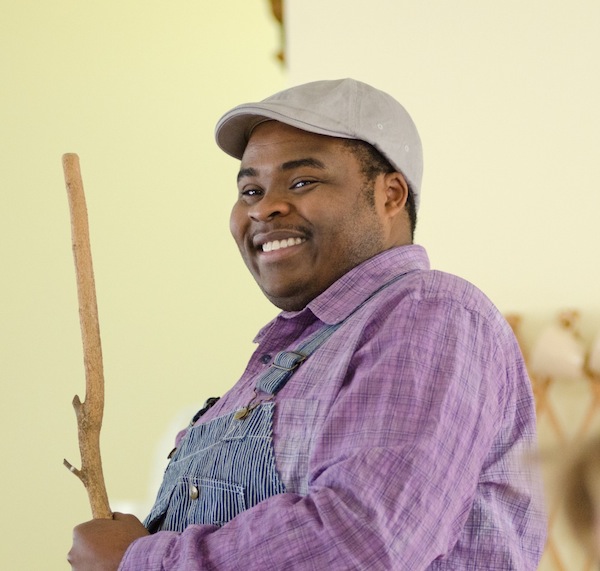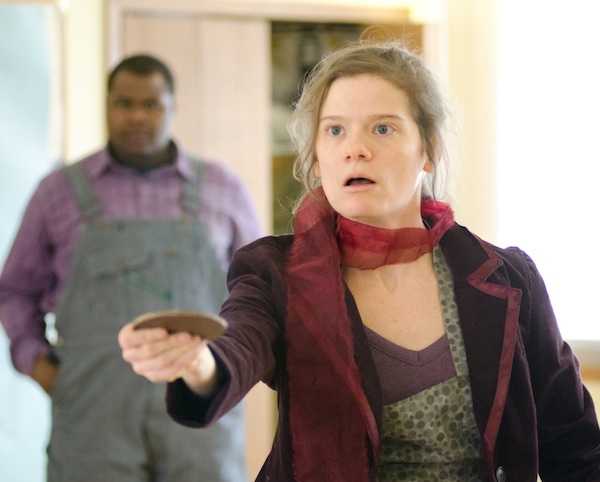
Hard questions for writers
By Kira Obolensky, Ten Thousand Things
Writers are often asked impossible questions. We might nod when we hear an impossible question. We might shrug or mumble an incoherent answer or remark upon the question-asker’s spiffy shoes. Impossible questions are almost always connected to the source of the creative work at hand. Every writer I know avoids answering these impossible questions. At all costs. And yet, right here in this very blog post, I am going to attempt to answer two of the hardest, most impossible questions of all. Read on!
First impossible question: Where do your ideas come from?
Dirt Sticks is the third play I’ve written for Ten Thousand Things. Because TTT brings theater to people who typically don’t have access, it becomes imperative when writing a play for this theater to consider that those who are going to see it will have a vast number of life experiences very different from my own. They are going to have, in short, a lot of their own stories. Working with this amazing organization has reminded me of something quite profound: stories really matter. They can illuminate, ground, implicate, agitate, soothe and bring pleasure. A narrative that is experienced together, imaginations collectively at work, can be an experience that at its simplest entertains and at its most profound reminds us of what it is like to consider another human being’s experience or perspective.
And then there are all of our collective stories—our fairy tales, our myths, our faiths—stories that enchant, disturb, comfort and provoke us. Dirt Sticks is about stories. We begin; It is told; the story of; this is my situation;end of story…Everyone in this play has a story to tell, or a story that is keeping them stuck. There are also stories that have not been told that can have real consequences for lives. Untold stories, I believe, have legacies. There are also the familiar stories that we fall into sometimes, like the story of finding a baby by a stream, or of believing so strongly in jealousy that you can’t see the truth; or even the story that love can save us. I believe in all of those stories, some more than others. I also think telling stories helps shape our collective experiences; it helps us make sense of lives and actions; and it can be a force for change. Telling stories, unraveling them, speaking what has been unspoken allows us to re-tell our own stories.
In Dirt Sticks, a Peddler comes to town with the Perigee Moon. He tells us he has “Everything under the moon” in his cart—and he really does. He tells us that he does Moon’s bidding, and that Moon is responsible for change.
The three important things for the play and for the change he wants to see happen are in his cart. The first is what the future might bring; the second is what has happened in the past; and the third is an untold story that needs to be told.
He also brings the power of the Moon. The Moon, I believe, represents something other than Earth. The Moon is magic; it’s also about yearning. This force of magical yearning meets the earth in all its stark earthiness–its dirt, its sticks, its violence and ugliness—and in the process of that meeting, a retelling, unraveling and remaking happens.
Second impossible question, especially for playwrights to answer: “Is the play like you imagined it?”
This is the hardest question of all for me to answer. Because when one is writing, lost in a made up world, the way that world looks and feels is always very different than whatever is going to happen to be on a stage. As it should be! A play is just a blueprint or a score. It’s never a representation in any way of a production. And that is because the imagination is such a mysterious thing—it draws and hears and projects and jump cuts and travels easily through space in time in ways in which theater, which is always told in “real time”, doesn’t. And production is always going to be about what the imaginations of other people bring to that blueprint. In the case of this production, it’s the talents of everyone who worked on the play, as well as the people who are going to be seeing it. The audiences become the completion of the way the production is imagined.
When I’m writing a play I am imagining a lot of things, among them: what people are saying,; how they are going to get on stage and off and why; what the time frame is; and what the places of the play are. Places may be the most easy to imagine as a writer, because they have physical realities that can be summoned. Dirt Sticks is told in a series of what I will call archetypal places: a factory where ladders are made—because ladders bring us up and down. And that’s what we, as humans, are in the business mostly of doing;
A forest, because forests are where truths and mysteries can be born;
A waterfall because that is an edge between “this and that,” and because it’s a precipice, a place where change can happen;
A moonlit night, because the moon stirs us in mysterious ways. I wanted these characters to be stirred, prodded and changed.
So while I may imagine a moonlit night when I write the words, “moonlit night,” I am also aware that in the theater any kind of moonlight, even at the fanciest theater with the highest production values, is going to be artifice—achieved through the hard work of a lighting designer. What’s so very interesting about writing for Ten Thousand Things is that when I imagine a moonlit night, I am aware that that moonlit night will have to be summoned by language and by the collective imagination of our audiences. And while I can imagine a moonlit night based on those nights I’ve experienced in my real life and in various theater spaces, the part that I can’t imagine, no matter how hard I try, is what I love so much about Ten Thousand Things. The collective experience of imagining a moonlit night is going to be better than anything I could have possibly imagined.
Same for characters. When I write, I do have a character’s voice very clearly in my head. But the best thing of all is when that voice I hear in my head is supplanted by the actor’s voice. And so when I consider that character, I then have the voice of the actor in my head. That’s what has happened for me in this rehearsal process. The actors have become for me the characters and vice versa (This may just be fatigue. Or middle age.)
But while I can hear a character in my head as I am writing, I can never ever see them. That’s because characters in plays are, in a way, skeletons, or sometimes even ghosts. Stage characters have to have enough room in them enough air in them, in their language, motivation, physicality to allow an actor to come into the role and fully embody them.
Theater is about summoning the imagination. Writing for the theater is about making a blueprint that allows a group of people to get together with another group of people and collectively imagine something together. Is Dirt Sticks like I imagined it?
Well, I can’t even remember how I ever imagined it before this production. And every time I see it, I am so informed by what the audience brings to it—how their imaginations engage with the stories told in the play. How they see their lives echoed or not by the experiences that are both unraveling and being forged by the playing.

Recent Content
-
Artsarticle ·
-
Artsarticle ·
-
Artsarticle ·
